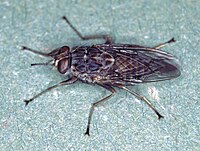
Genetic diversity and population structure of the tsetse fly Glossina fuscipes fuscipes (Diptera: Glossinidae) in Northern Uganda: Implications for vector control
Sign Up to like & getrecommendations! Published in 2017 at "PLoS Neglected Tropical Diseases"
DOI: 10.1371/journal.pntd.0005485
Abstract: Uganda is the only country where the chronic and acute forms of human African Trypanosomiasis (HAT) or sleeping sickness both occur and are separated by < 100 km in areas north of Lake Kyoga. In… read more here.
Keywords: vector; lake kyoga; fuscipes fuscipes; drainage ... See more keywords

Spatio-temporal distribution of Spiroplasma infections in the tsetse fly (Glossina fuscipes fuscipes) in northern Uganda
Sign Up to like & getrecommendations! Published in 2019 at "PLoS Neglected Tropical Diseases"
DOI: 10.1371/journal.pntd.0007340
Abstract: Tsetse flies (Glossina spp.) are vectors of parasitic trypanosomes, which cause human (HAT) and animal African trypanosomiasis (AAT) in sub-Saharan Africa. In Uganda, Glossina fuscipes fuscipes (Gff) is the main vector of HAT, where it… read more here.
Keywords: gff; spiroplasma infections; infection; spiroplasma ... See more keywords

On the genetic basis of the effect of Spiroplasma on the male reproductive fitness of Glossina fuscipes fuscipes
Sign Up to like & getrecommendations! Published in 2022 at "PLoS Pathogens"
DOI: 10.1371/journal.ppat.1010442
Abstract: Son and colleagues recently reported [1] the phenotypic effects of the infection of the endo-symbiont Spiroplasma in the tsetse fly Glossina fuscipes fuscipes , a major disease vector in humans. The authors examined the impact… read more here.
Keywords: fuscipes fuscipes; effect; glossina fuscipes; male reproductive ... See more keywords

Cellular and Molecular Targets of Waterbuck Repellent Blend Odors in Antennae of Glossina fuscipes fuscipes Newstead, 1910
Sign Up to like & getrecommendations! Published in 2020 at "Frontiers in Cellular Neuroscience"
DOI: 10.3389/fncel.2020.00137
Abstract: Insects that transmit many of the world’s deadliest animal diseases, for instance trypanosomosis, find their suitable hosts and avoid non-preferred hosts mostly through olfactory cues. The waterbuck repellent blend (WRB) comprising geranylacetone, guaiacol, pentanoic acid,… read more here.
Keywords: waterbuck repellent; fuscipes fuscipes; repellent blend; fuscipes newstead ... See more keywords